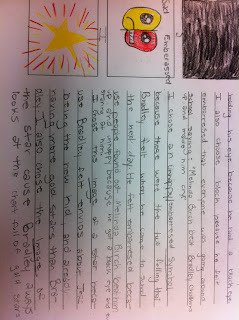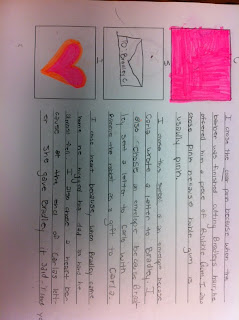 |
| (Thanks for the pictures, Jim!) |
During our CoT seminars, we learned about the 8 Cultural Forces. Looking back on our PD session, I'm thinking about the video we watched through the lens of these 8 Cultural Forces, particularly the forces of...
- language (using a language of thinking that provides students with the vocabulary for describing and reflecting on thinking)
- modeling (modeling of who we are as learners and thinkers so that the process of our thinking is discussed, shared, and made visible)
- environment (making thinking visible by displaying the process of thinking and development of ideas).
I wonder how you think these cultural forces were at play in the video?
 Looking over my notes from the Late Start, I really liked the idea of a "Thinking Word Wall" that supports the language and vocabulary of thinking and learning. When I was in the classroom, I had content word walls and a word wall for word study but never thought of a having a word wall for the language I want to foster in my room. Sitting in this session made me want to be back in the classroom!
Looking over my notes from the Late Start, I really liked the idea of a "Thinking Word Wall" that supports the language and vocabulary of thinking and learning. When I was in the classroom, I had content word walls and a word wall for word study but never thought of a having a word wall for the language I want to foster in my room. Sitting in this session made me want to be back in the classroom! Connections to CoT:
- I noticed that the conversation about "What is it like to think like a scientist, mathematician, or historian?" had a strong connection to Cultures of Thinking. I was particulary struck by Tom and Michelle's comments that there was overlap between all three and that the headings could really be removed.
- The overarching question they referred to in the video reminded me of the themes or "through lines" that Anna, Jim, and Lis observed during their visit to Way Elementary. I'm curious to hear from them about whether or not this overarching question was similar to Way's "through lines."
- The culture of thinking and learning in the video was compelling. Like we discussed at our CoT seminars, you can't fake this! What did all of you think about the culture of this classroom?
Overall, I felt that Margaret's session was closely aligned to our CoT initiative and will be helpful to us as we continue our journey. The learning our teachers experienced on Wednesday will provide a shared experience to refer back to during future late starts and conversations. It also provided a foundation in the principles and values of Cultures of Thinking.
Please leave a comment (no matter how short) ...your ideas matter! We can push our thinking forward and motivate each other!












